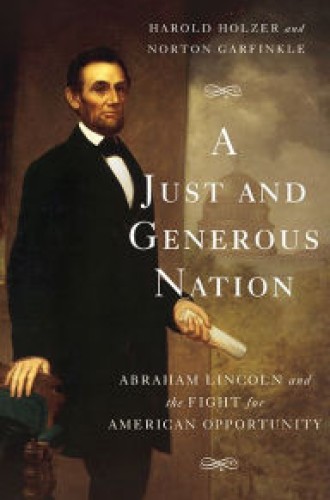Emancipation and economics
We are, happily, not finished with Abraham Lincoln, nor shall we ever be. Lincoln’s singular combination of principle, passion, and cunning makes him a continuing reference point for our democratic future. Because he was exceedingly cagey on the execution of the Civil War, deliberately ambiguous about policy, and capable of continuing growth, it is not easy to determine his political intention at every turn. His war policy at the outset was designed not to “free the slaves,” but to “preserve and maintain the union.” Harold Holzer and Norton Garfinkle propose that Lincoln’s fundamental cause was for “free labor.”
Lincoln had in purview both his own hard scrabble life in his early days and the life of his unsuccessful father. Lincoln meant by “free labor” that every American should be free to advance to the “middle class” and to enjoy the fruit of his own labor. Labor’s produce should not be siphoned off to support non-laborers (the ownership class) in a way that denies prosperity to those who do labor.
Read our latest issue or browse back issues.
Lincoln’s political aim was to assure that states added to the Union in the west remained free from slavery. His reasoning was twofold: slave labor competes unfairly with free labor, and slave labor denies the slaves prosperity from their own labor. The task, to prevent any more slave states, tacitly recognized that slavery could not continue in a Union with a growing and disproportionate number of states assuring free labor.
At the same time, Lincoln fully respected the constitutional guarantees for slavery in the southern states. He was for some time no advocate of abolition. He eventually justified the emancipation of slaves as a military necessity that was otherwise precluded by the Constitution.
But he kept his eye on the new states that must be free for free labor. Thus Lincoln declared in 1861: “Labor is prior to, and independent of capital. Capital is only the fruit of labor, and could never have existed if labor had not first existed. Labor is the superior of capital, and deserves much the higher consideration.” And in 1864 he averred:
The world has never had a good definition of the word liberty, and the American people, just now, are in want of one. We all declare for liberty; but in using the same word we do not all mean the same thing. With some the word liberty may mean for each man to do as he pleases with himself, and the product of his labor; while with others the same word may mean for some men to do as they please with other men, and the product of other men’s labor.
Lincoln stated clearly in his “house divided” rhetoric that the Union could not tolerate the democratic practice of free labor and at the same time the aristocratic practice of slave labor that offered unfair competition. Thus, Holzer and Garfinkle contend, the war was fought in order to create a venue for free labor that would not need to compete with an ownership class that lived off the labor of others.
The authors trace the complex political and military steps whereby Lincoln shepherded the Union “to the proposition that all men are created equal”—both equal in opportunity and equal in the chance to enjoy prosperity from free labor. Lincoln saw “that slavery was immoral because it violated the just position that one person should not own the fruits of the labor of another person—black or white.” As the war progressed, Lincoln tilted more and more toward a focus on the providential mystery of God. Eventually he asserted that it was God who had decided to emancipate the slaves.
All of that is offered in the first half of the book. The second half is a stunning reflection on the trajectory of Lincoln’s passion as it continues to recur in the political discourse and action of the Union. These latter pages review the titanic struggle over restoration and reconstruction in the postwar years.
As aristocratic modes of labor made a strong comeback, the emancipation of slaves was nullified in practice by the wholesale reduction of freed labor to tenant farming, which amounted to a new serfdom. The Industrial Revolution obliterated Lincoln’s hope for a society of independent small-time artisans, as workers were swallowed up in large conglomerates of wealth that eventuated in the Gilded Age. The old reality of a “house divided” reappeared in the tension between democratic and aristocratic notions of labor (a tension that persists into our own day). The grip of that “slavery by another name” was not broken until the flight north to factory jobs during World Wars I and II. Only then did the American Dream (defined as the capacity for economic freedom) become available to large numbers of workers who for the first time practiced free labor.
For a half century after Lincoln, the U.S. government favored industrialists with tax advantages and sweetheart deals. That pernicious labor arrangement was not effectively interrupted until Theodore Roosevelt’s antitrust program, Woodrow Wilson’s reforms (his racism notwithstanding), and the New Deal. Lincoln’s vision was contradicted by laissez-faire economic theory and a militant practice of Social Darwinism whereby all African Americans came to be regarded as “losers,” “the unfit” who could readily be “left behind.” Free labor was effectively supported with the New Deal, which worked against the exploitative policies and resegregation of the post-Lincoln era.
The book finishes with a strong suggestion that the issues swirling around Barack Obama are a continuing challenge of Lincoln’s legacy. The authors judge that “the American Dream” is in a deep contest with “the Gospel of Wealth” championed by Andrew Carnegie. Thus they claim that the American Dream is “carried forward by Presidents Theodore Roosevelt, Woodrow Wilson, Franklin Roosevelt, Lyndon Johnson, and more recently by William Jefferson Clinton and Barack Obama.”
Conversely the Gospel of Wealth’s “supply-side economic idea . . . is carried forward by Presidents Warren G. Harding, Calvin Coolidge, Herbert Hoover, and more recently Ronald Reagan and George W. Bush.” In particular, the authors attribute to Ronald Reagan a pivotal false use of Lincoln’s wisdom that in fact resists Lincoln’s intent and vision.
This compelling and persuasive book shows how the old “house divided” persists in contested claims about the American Dream and who has access to it. Ta-Nehisi Coates parses the dream as a white notion of a life of privilege that depends upon the cheap labor of others. Lincoln understood that the dream of well-being, if not radically democratized, could only be a nightmare for some. It remains to be seen whether our political energy can be mobilized on behalf of the just and generous nation that Lincoln had in mind. In any case Mr. Lincoln is, happily, not finished with us yet.







